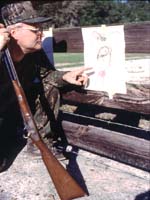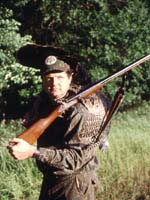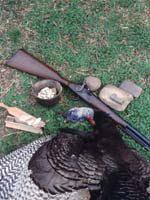
|
Features
|
|
|
|
Books
|
|
|
|
Fun & Games
|
|
|
|
Contact Us
|
|
|
John's Journal... Entry 82, Day 3
Loads for Blackpowder Turkeys
 EDITOR'S
NOTE: Two of the fastest-growing sports in America today -- turkey
hunting and black-powder hunting -- add a new dimension to both these
sports. Combining these two sports also tests the mettle of the hunter
more since he must be very precise, give forethought to the sport and
employ all his woodsmanship skills for success. Black-powder hunting for
turkeys also provides an added challenge and makes the trophy far more
valuable and more exciting to hunt than when you utilize conventional
weapons.
EDITOR'S
NOTE: Two of the fastest-growing sports in America today -- turkey
hunting and black-powder hunting -- add a new dimension to both these
sports. Combining these two sports also tests the mettle of the hunter
more since he must be very precise, give forethought to the sport and
employ all his woodsmanship skills for success. Black-powder hunting for
turkeys also provides an added challenge and makes the trophy far more
valuable and more exciting to hunt than when you utilize conventional
weapons.
When you hunt turkeys with a black-powder shotgun, you have an advantage over the conventional shotgun hunter because you can modify each individual load. You can improve the pattern of your black-powder shotgun in several different ways. You can use more or less powder -- generally 1-1/8- to 1-1/4-ounces of powder. One and one-eighth ounces of Pyrodex is equal 80 grains of 2F black powder. The 1-1/4-ounce charge of Pyrodex is equal to 90-grains of 2F black powder. You can utilize either Pyrodex or black powder when formulating your charges.
The choice of powder also can be changed according to weather conditions. Generally, black-powder hunters prefer 2F black powder on rainy days or days when the humidity is very high. This old conventional black powder doesn't seem to absorb as much moisture as Pyrodex does. However, black-powder hunters often argue about this theory. On clear, dry days, often Pyrodex is preferred because it tends to burn cleaner.
By testing both powder charges, you can determine which charge produces the best pattern for you. The 1-1/8-ounce charge often yields a denser pattern. Often the 1-1/4-ounce charge tends to blow the pattern out -- spreading the shot over a wider area. The shot doesn't stay as dense in the target area as it does when using the 1-1/8-ounce charge. However, each gun shoots somewhat differently, and the combination of wadding and shot may have various effects with each of these two charges.
 Another
method of improving your pattern without adding or reducing your powder
charge is the amount or type of overpowder wadding or cushion you use.
If you select a cardboard kind of overpowder wadding, you often can change
your pattern by trimming the thickness of the cardboard to increase or
decrease the size of the wadding.
Another
method of improving your pattern without adding or reducing your powder
charge is the amount or type of overpowder wadding or cushion you use.
If you select a cardboard kind of overpowder wadding, you often can change
your pattern by trimming the thickness of the cardboard to increase or
decrease the size of the wadding.
Yet another way to tighten your pattern is to use the plastic shot cups like those found in modern-day shotgun shells. Often a black-powder hunter prefers this type of wadding because he's learned that less deformity occurs in the shot when the powder is ignited and the shot travels down the barrel protected by the plastic cup than when using the cardboard type wadding, which means the shot will come into contact with the barrel after ignition. The modern, plastic-shot cup seems to have a better cushion in it to absorb some of the shock when the powder explodes. This shock-absorbing feature of the modern plastic shot cup prevents the lead pellets from being smashed together and deformed as much when the powder explodes.
An advantage to utilizing the plastic shot cup is this particular kind of wadding encases the lead shot in a protective covering as it travels down the barrel, which also seems to aid in preventing deformity of the shot by keeping the shot from hitting the sides of the barrel as it travels the length of the barrel before it exits. Once the shot leaves the barrel, the plastic shot cup seems to hold the shot together longer, which tends to produce a tighter pattern than if the shot spreads out as soon as it leaves the barrel like a cardboard wadding permits.
However, other black-powder hunters believe the cardboard kind of wadding is more traditional and shoots just as tight a pattern as a plastic shot cup. But, always use the wadding system that produces the best pattern for you and your gun. Regardless of which type of wadding system you utilize, you must use an overshot cardboard patch to keep the shot from rolling out the end of the barrel.
Another option that determines pattern density is the amount of pressure you use to pack your load. Many black-powder shotgunners are convinced the overpowder wadding and the overshot wadding must be rammed home and forced down the barrel snugly. However, if you pack the powder and the shot tight in the barrel by adding more pressure to the ramrod, you can decrease the size of the volume of the powder and increase the rate at which it expands. If you ram your shot and cup home too hard, you may create such a tight compression of the powder you may blow your shot pattern out.
 Sometimes
a hunter will experiment with duplex loads -- mixing No. 4 shot and No.
6 shot together, and even combining No. 2, No. 4 and No. 6 shot. However,
you may find that in your black-powder shotgun the No. 6 shot produces
the densest pattern at 30 yards, since each gun patterns differently.
Or, you may discover that No. 4s or No. 7-1/2s will produce a better shot
pattern in your gun. The more pellets you can put in a turkey head target
at 30 yards, the better your odds will be for bagging a bird with a black-powder
shotgun.
Sometimes
a hunter will experiment with duplex loads -- mixing No. 4 shot and No.
6 shot together, and even combining No. 2, No. 4 and No. 6 shot. However,
you may find that in your black-powder shotgun the No. 6 shot produces
the densest pattern at 30 yards, since each gun patterns differently.
Or, you may discover that No. 4s or No. 7-1/2s will produce a better shot
pattern in your gun. The more pellets you can put in a turkey head target
at 30 yards, the better your odds will be for bagging a bird with a black-powder
shotgun.
To learn more about CVA's black-powder guns, call (770) 449-4687; email info@cva.com; or, see the catalogue online.
To learn more about hunting turkeys, go to Night Hawk's home page, and click on books to find out information about John Phillips' three turkey-hunting books: "The Masters' Secrets of Turkey Hunting," "Outdoor Life's Complete Turkey-Hunting Book" and "Turkey Tactics." Call (800) 627-4295 to order.
TOMORROW: Blackpowder Accessories
Check back each day this week for more about Blackpowder Turkeys ...
Day 1 -Bagging Turkeys with
Blackpowder
Day 2 -Using Blackpowder Guns for Hunting
Turkeys
Day 3 -Loads for Blackpowder Turkeys
Day 4 -Blackpowder Accessories
Day 5 -Tricks of the Trade